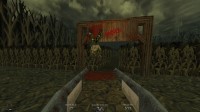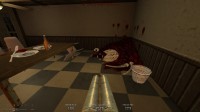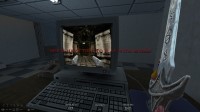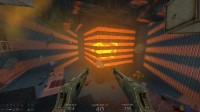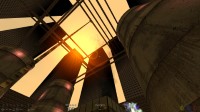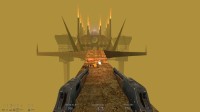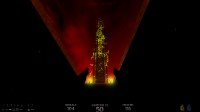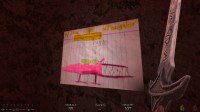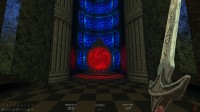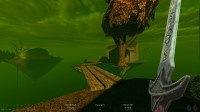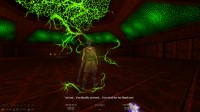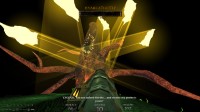DUSK
Playtime: 9 Hours
Finished 25 August 2024.Beat the game over the span of just a couple of days, it's only 3 episodes with no expansions so it really didn't feel like too much of a time investment. Played it through using the DUSK HD textures, on Cero Mielo difficulty which is the highest non-joke difficulty (Duskmare is 1HKO). I did play probably around 30 minutes with the original graphics before I switched since I liked the HD look a bit better, so the real time taken to beat all of the episodes was ultimately around 8.5 Hours. I did use a guide to find the secret levels, but otherwise didn't look at any other walkthroughs or reference material. I did end up savescumming a couple sections towards the end of the game (especially E3M9, IYKYK - did not skip that level), but probably played around 95% of it fully legit - as usual, lots of quicksaving but not much quickloading.
This game was on my radar for quite a few years as one of the first major releases in the early days of the old-school shooter revival. Right from the start, this game wears its inspirations proudly - throwing three Leathernecks at you in the very first room in a tribute to Texas Chainsaw Massacre, then taking you through a grim backwater filled with strange cultists and devilish enemies throughout its first episode in a style very similar to BLOOD. Later episodes take you through rusty industrial facilities somewhat reminiscent of the brutal steel corridors of Quake 2, while the last episode is comprised of medieval & mystical settings, which start out looking like Quake or Heretic but evolve into something out of a strange Lovecraftian horror by the end. With that being said, at no point did this game feel derivative or tired, like a clone of its ancestors; it forges an identity wholly its own through the gameplay and visual design, making tribute to the key elements that made old-school shooters fun to begin yet evolving the genre for the new generation.
The key aspect in which this game really shines is the gameplay, comprised in this case by the feel of the movement and weaponry. I felt that the movement in particular was very heavily inspired by Quake 2; with the main method of momentum gain being Q2/3-style strafejumping rather than the more elegant bhopping in Quake 1 & GoldSrc games. While I would have strongly preferred a Q1-style movement system, I understand that it's much harder to learn and master and mostly impacts the fluidity of movement, rather than the raw speed that is preferable in this game's large, flat maps. Not to be outshone, the player's arsenal feels both powerful & versatile - comprised of many familiar classics, and a few interesting additions. While the base pistols and single-shotgun generally get abandoned for the hard hitters by the middle of each chapter, they still have their uses in cleaning up the occasional trash mob. The closest thing to a criticism that I can raise against the guns of DUSK is that the ammo capacity tends to be quite low for certain weapons, but ammo pickups are everywhere which makes this complaint somewhat moot. Even the two melee weapons are fun to use; the sickle has the ability to deflect projectiles with timed strikes, especially useful against certain enemy types with homing attacks, and the raw power of the Sword actually ends up being a fairly preferred weapon for many boss encounters. There's pretty much no weapon or resource in the game that feels neglected or frivolous, which is very extreme praise given that you have around 10 of them in this game.
The other half of the equation is the enemy and level design - in other words, how the game's environment reacts to your gameplay. On Cero Miedo (the hardest difficulty before Duskmare), I find that the balance feels just right, requiring good movement skills to dodge the (really fast!) projectiles without punishing too hard for the occasional mistake. The smooth Q2-like movement system shines brightly here, essentially allowing the player to dash away from enemies that may otherwise keep pace with them and allowing for a more controllable combat flow. This leads to one of the best decisions in this game's overall design principles, which is that all ranged enemy attacks are projectile attacks (ie. no hitscan BS). In theory, everything is dodgeable if the player is good enough, and this also encourages the more open level design that is seen in this game, feeding back into the fast-paced combat and frantic scrambling that I mentioned earlier instead of forcing a corner-peeking, thumb-sucking playstyle. The last piece of the puzzle here is that the enemies aren't super durable, nor does their tankiness scale heavily by difficulty - instead, there are just a lot of them cleverly placed throughout the maps to catch you off guard, making you play quickly yet cautiously. The flow of the game is very nearly perfect (outside of E3M9, which is a bit of a slog mostly due to very poor visibility), and the maps feel fast yet large, with interesting secrets that don't take a ton of time to find.
I don't have much to say about this game in the negative; the three episodes felt like an extremely complete experience - taking me to a wide variety of interesting environments and levels without ever feeling boring, yet ending at just around the perfect time without overstaying its welcome. It's possible that a fourth episode without any major changes would have been a bit too much; I imagine there's only so much you can realistically do to keep the same roster of enemies & weapons interesting, and it would have been very difficult to top the atmosphere of the third episode. For pretty much every other aspect I can think of - the music, the visuals (both OG and HD, even though I slightly preferred HD and played the game with the new models & textures), the performance - the game is absolutely ironclad. Even above the vast majority of the old classics, I think DUSK reigns.
